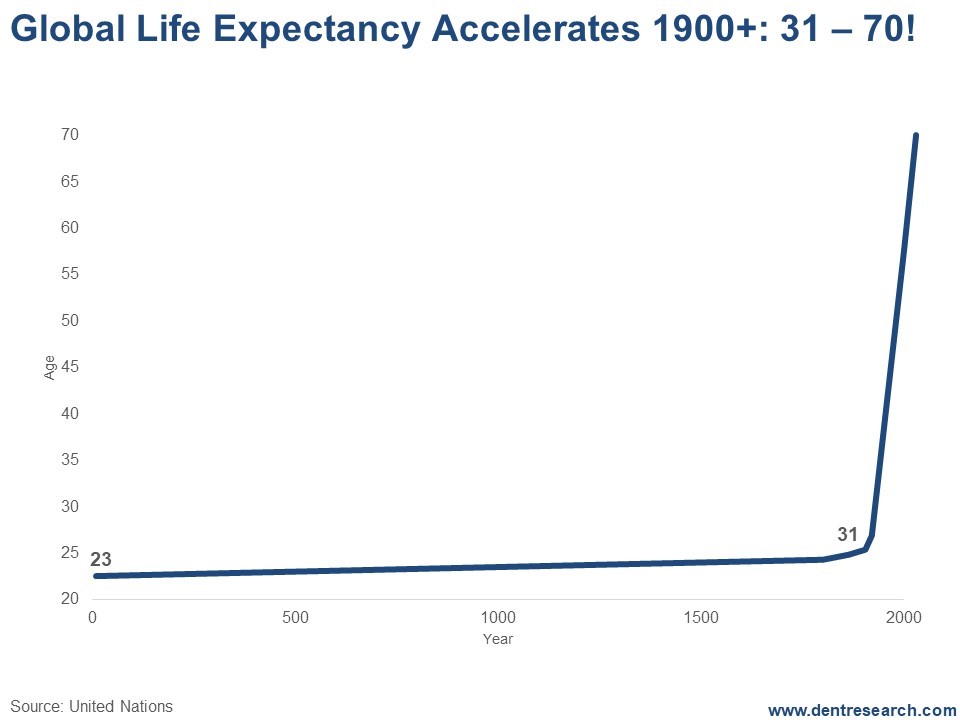This is incredible!
Life expectancy at birth was around age 23 at the time of Christ.
It stayed between 23 and 26 until 1700.
Then it gradually increased to age 31 by 1900!
Since then, it has literally exploded!
Check out this amazing chart!
That’s no error!
Life expectancy has more than doubled in the last century. In the U.S. and developed countries, it went from 47 to 80.
Hell yeah, baby!
But what the hell could have caused this?
In two words: technology and urbanization.
Various scientists and engineers contributed to the creation of the combustion engine in the late 1700s. The first real combustion engine came to life (and patent) around the mid-1880s. By 1900, the first commercial car was sold. Trucks, buses, and tractors followed quickly.
Do you know how much tractors revolutionized farming?
In the late 1800s, growing our food was done 80% by people. Now it takes only 1.5% for that and major exports to boot!
Oh, and electricity and light bulbs were just emerging along with phones during that period.
Urbanization started to accelerate in Europe in the late 1800s and sped up globally from 1920 forward, when the world was just 12% urban.
Today, the world is 55% urban.
I project it will be 90% urban by 2120. And global income per capita will go up another four times.
1896 was the low in inflation rates for hundreds of years… and the start of a long term, 500-year inflation and mega-innovation cycle that doesn’t peak until about 2145…
This is why I look at cycles longer than your or my lifespan.
The truth is we are in the first mass production revolution in history and on a worldwide tear for urbanization.
In recent decades jet travel, personal computers, and the internet have emerged to unite the world in communication.
The truth is that more progress has been made in the last 120 years than in all of history put together.
And our life expectancies reflect that.
People who think the world is going to hell in a hand basket are blind!
That’s what a new book called Factfulness is saying. And I absolutely agree.
You should get the book for your kids. It’ll keep them off opioids.
The bigger truth is that our lives today are a result of a convergence of technologies that actually sprung out of the Scientific Revolution of the 1700s and free market capitalism and democracy in the late 1700s. That’s a 250-Year Revolution Cycle.
But it was the emergence of the 500-year cycle that brought the greatest explosion in technologies and standard of living in history since 1900.
Increasing lifespans was a byproduct of our wages increasing eight times (adjusted for inflation) since 1900.
But increasing lifespans also feed positively into the explosion by allowing us to be in the workforce much longer and earn and contribute more over a lifetime. That has been a part of the “demographic dividend of the last century that our research has so well documented.
Imagine what happens when the next surge comes in our kids and grandkids lifetimes… and people live to be 100 or 120…
Maybe they’ll have two sets of two kids.
That will solve the seemingly inevitable demographic black hole of affluent urban societies naturally having fewer children, which the 500-year cycle would strongly forecast.
Possibly even more important, they could learn on the first set of kids and produce perfect kids on the second go!
I wish I could live long enough to see that.
The content of our articles is based on what we’ve learned as financial journalists. We do not offer personalized investment advice: you should not base investment decisions solely on what you read here. It’s your money and your responsibility. Our track record is based on hypothetical results and may not reflect the same results as actual trades. Likewise, past performance is no guarantee of future returns. Certain investments such as futures, options, and currency trading carry large potential rewards but also large potential risk. Don’t trade in these markets with money you can’t afford to lose. Delray Publishing LLC expressly forbids its writers from having a financial interest in their own securities or commodities recommendations to readers.
Recommended Content
Editors’ Picks
AUD/USD remained bid above 0.6500

AUD/USD extended further its bullish performance, advancing for the fourth session in a row on Thursday, although a sustainable breakout of the key 200-day SMA at 0.6526 still remain elusive.
EUR/USD faces a minor resistance near at 1.0750

EUR/USD quickly left behind Wednesday’s small downtick and resumed its uptrend north of 1.0700 the figure, always on the back of the persistent sell-off in the US Dollar ahead of key PCE data on Friday.
Gold holds around $2,330 after dismal US data

Gold fell below $2,320 in the early American session as US yields shot higher after the data showed a significant increase in the US GDP price deflator in Q1. With safe-haven flows dominating the markets, however, XAU/USD reversed its direction and rose above $2,340.
Bitcoin price continues to get rejected from $65K resistance as SEC delays decision on spot BTC ETF options

Bitcoin (BTC) price has markets in disarray, provoking a broader market crash as it slumped to the $62,000 range on Thursday. Meanwhile, reverberations from spot BTC exchange-traded funds (ETFs) continue to influence the market.
US economy: slower growth with stronger inflation

The dollar strengthened, and stocks fell after statistical data from the US. The focus was on the preliminary estimate of GDP for the first quarter. Annualised quarterly growth came in at just 1.6%, down from the 2.5% and 3.4% previously forecast.
